As has already been mentioned on this blog, the Indiana University Libraries Film Archive (IULFA) recently posted close to 200 films from its collection for streaming. This effort is an important part of the Archive’s, as well as the IU Libraries’, central mission of providing access to students, faculty, researchers, and the larger public to our collection of over 80,000 films. This monthly series of blog postings, which we’re calling “Presenting…”, will examine one of these streaming films in greater detail, look at its production and exhibition history, and connect them to the wider field of film scholarship, moving image archiving, and media pedagogy.
This first batch of films we’ve put online were made by the University’s Audio-Visual Center, or AVC for short.
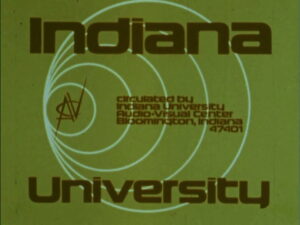
The AVC was founded in 1912 (Happy 100th Birthday!) and it functioned until the beginning of our current millennium. During its existence the AVC worked to create and distribute educational materials in the new media formats of the day, be they magic lantern slides and photographs, motion picture film, videotape, or computer programs. Most relevant to our work as a film archive the AVC distributed over 35,000 titles from a variety of educational film producers, as well as making its own line of award-winning films that benefited greatly from the expertise of IU’s professors. In later postings we will look more closely at some of these classroom films that explored the functioning of biological lifeforms, the structural inequalities that held back lower income Americans, the ways to teach with electronic and photographic media, and other topics in the hard and soft sciences.
The AVC also made a number of films about Indiana University. It seems appropriate to start this blog series presenting the film work of Indiana University with a 1961 film, Presenting Indiana University, that presented the college to potential students.
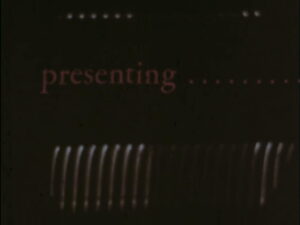
As we are still in the process of researching the production and exhibition methods of the AVC, which we are doing with the help of PhD candidate Natasha Ritsma and the University Archives, we have not yet come across any specific documents that detail how this film was used. But other research has uncovered the work of the University’s Junior Division whose representatives traveled across Indiana with a spiel for high school students about what IU had to offer them. Promotional films such as Presenting Indiana University were an important part of their persuasive appeal. According to the 1967 edition of the IU yearbook, Arbutus, “Junior Division counselors go to the high schools for ‘College Day’ or ‘College Night’ programs to acquaint students with University policies and opportunities. Through films and discussions with Junior Division counselors, freshmen can learn what I.U. is like long before they arrive.”
Assuming Presenting Indiana University was used for this purpose, what would prospective students have learned about IU from watching the film? These individuals would have been exposed to the wide range of educational opportunities that the University had to offer them. A high school student who was deciding which college to attend would have seen a University that paid equal attention to the hard sciences – the film shows an experiment testing the human body’s reaction to painful sound frequencies, which you can see at the 1:40 mark in the video – and the creative arts and humanities, which is represented by footage of a composer working at the piano. By having two examples, each focused on sound and our physical and emotional response to it, the film explicitly notes how both the sciences and the humanities are working towards the same goal, which is to “know our selves better.”
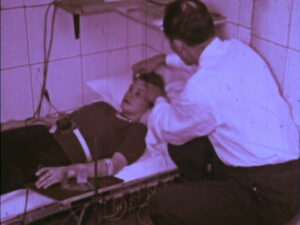
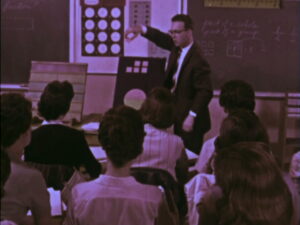
Potential IU attendees would have also gained a sense of the social atmosphere of the campus by watching the film. They would have seen a student body integrated by gender and race, though the faculty was still, as seen in this film at least, entirely white men. High school students would have gained a sense of the respectful classroom environment at IU, where professors mixed lectures with probing questions to their class that seem designed to elicit engaging discussions. Though these in-class sections might seem a little staged now, the scenes show students grappling with heady intellectual material, such as the sequence in Dr. Henry Beech’s philosophy seminar where he and a young woman debate the freedom of choice available to a narcotized society, which can be viewed at the ten-minute mark.
Just as importantly, viewers would have learned that a University is much more than only the classroom. They would have seen the breadth of departments and facilities that supported their educational career at IU including the libraries (the film shows the new reading rooms and the priceless artifacts of the Lilly Library), the advising system offered by the Junior Division, the state-of-the-art computer center, and, of special interest to our archival work, the IU film library and audio-visual support center.
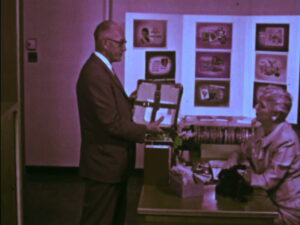
Further, by watching the film high schoolers would have seen all of the ways they could have gained practical experience while at IU including a number of student theater groups, teacher training programs, and the student newspaper. They would have received a sense of the world-class entertainment offered at IU including lectures by Nobel prizewinners, operas by the Music School, football games, art openings, and proms.
However, since this film no longer fulfills its intended purpose, what is the value of watching it today? Well, there are the always entertaining differences between then and now that one finds in old films, such as buildings that are no longer standing and changes in clothing worn by students – college men used to wear ties like nobody’s business! More importantly however, this film provides revealing insights into how a university justified its existence fifty years ago. It’s no secret that higher education is currently facing a myriad of challenges from declining state funding, rising tuitions, and the disruptive yet beneficial shockwaves of the digital transformation. Presenting Indiana University doesn’t directly address these concerns or provide us with any easy answers in 2012. But it does provide us with a clear sense of the central purpose of a university, which is to, as the film’s narrator states, “help each student probe the limitless frontiers of his own mind” in the goal of transforming them into “a contributing citizen in our modern society.” As the gendered use of the word “he” implies, we have to continuously update these goals for our current times, exegencies, and community. But as the film makes explicit throughout, the unfettered but directed pursuit of knowledge, however ridiculous it might appear – check out the sequence where they are bombarding a woman with painful sounds again – has a clear benefit to students as individuals and the society they enter when they graduate.
Like all universities, IU has continued to make these sort of promotional films. If you’re interested, you can check some recent examples of this genre of film/video making out at the IU YouTube page. These current videos cover many of the same topics as Presenting Indiana University, but, not surprising considering the shorter duration of YouTube videos, are broken up into more discrete chunks. Comparing these newer videos such as IU Extraordinary, Welcome Home, and This is Your Epic Adventure (all below) to Presenting Indiana University shows the continuity and changes in how a university promotes itself. While many of the same issues are covered, the student’s individual experience, on an academic and emotional level, takes center stage in a way not found in the 1961 film. Part of this difference can be explained by changes in the technology and styles of filmmaking; video records live sound in a way that was more complicated to achieve in 1961 and we expect people to speak for themselves instead of only hearing from a voice-of-god narrator. However, the change suggests a greater emphasis on the student’s mental and physical wellbeing than just the intellectual aspects focused on in Presenting Indiana University. To conclude, looking at these old promotional films, especially in relation to current publicity campaigns, affords an understanding of what a university thinks is most important at that particular time. This can reveal whom they were trying to appeal to and which social, political, and economic forces they were responding to.
IU Extraordinary
Welcome Home
This is Your Epic Adventure
http://www.youtube.com/watch?v=XfHFU0Vx_9A&feature=related
~Andy Uhrich